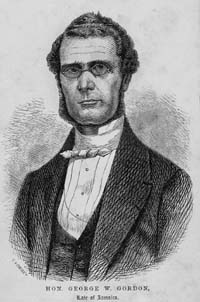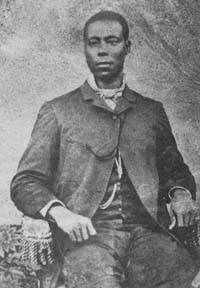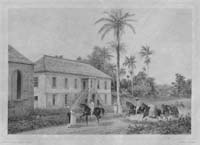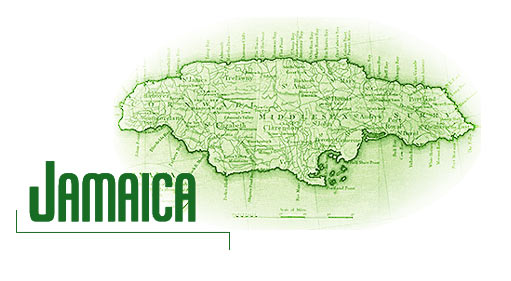
A
courthouse filled with white planters and judges, is surrounded by a
mob of hundreds of black laborers, and set ablaze.
A white flag calling for peace is put out, at which the people
scoff. Anyone trying to flee
is hacked to pieces. In the end
twenty-five people are dead, including eighteen justices, magistrates,
and volunteer guards from inside the courthouse, and another thirty-one
people are injured. What could possibly have enraged this mob to
the point that they would massacre a group of local politicians and
innocent people in such a horrific manner?
The causes go much deeper than the simple explanation offered
by the colonial government: a mob rescuing a fellow black man who was
charged with trespassing on an abandoned plantation.
The origins of what took place on October 11, 1865 are much larger than any single event
that immediately preceded the ‘Morant Bay
Rebellion.’ They included years
of neglect by a government that by no means represented the masses of
former African slaves, an economy that was sliding out of control, leading
to enormous unemployment rates, and high prices of any imported food
or clothing, which left people practically nude and starving in every
city and town on the entire island of Jamaica.
All these causes directly or indirectly led to the violence that
spread out of control in the once quiet town of Morant Bay.
A
government must have the ability to care for the governed masses through
institutions such as healthcare and to manage the economy in a responsible
manner that benefits not only the upper classes, but the entire populace. Too, a democratic government must represent
the people it is attempting to govern.
In Jamaica none of the above were true. In Jamaica the population ratio of blacks to
white was thirty-two to one at the time of the elections of 1864. Yet, out of a population of over 436,000 fewer
than 2,000 were eligible to vote, and those were almost exclusively
white, due in part to a large voting fee that blacks had to pay in order
to participate.
[1]
As one obsserver stated,
“they possess no effectual voice in the making of laws which touch their
interests.”
[2]
George W. Gordon, a wealthy  son
of a white planter and slave woman, was elected to House of Assembly
in 1865 as an advocate for the impoverished blacks in Jamaica.
The now infamous governor Edward Eyre publicly denounced him
as, “the most consistent and untiring obstructer of the public business
in the House of Assembly.”
[3]
Gordon shot back, saying of Eyre, “…he is devoid
of justice and humanity.” Gordon’s
disgust for Eyre’s policies can be seen when he stresses in a letter
to a friend, “…he will not admit reforms…there is fast being created
a second bondage in Jamaica.”
[4]
Gordon had perceived not only the deteriorating
state of Eyre’s Government on the island, but also the poor slave-like
conditions in which the masses of emancipated blacks lived. Even the most basic institutions such as hospitals
or housing for the old and poor were neglected. There were reports from bishops and charitable
samaritans that poor
houses, void of doors and windows, were filled with dying people who
would lie on the floors without food or water.
The dead would go unburied, sometimes for days at a time.
[5]
When the government had so little respect or
care for the people, the disregarded masses would rise up at the slightest
provocation, against any figures of authority.
That is exactly what happened at Morant Bay. son
of a white planter and slave woman, was elected to House of Assembly
in 1865 as an advocate for the impoverished blacks in Jamaica.
The now infamous governor Edward Eyre publicly denounced him
as, “the most consistent and untiring obstructer of the public business
in the House of Assembly.”
[3]
Gordon shot back, saying of Eyre, “…he is devoid
of justice and humanity.” Gordon’s
disgust for Eyre’s policies can be seen when he stresses in a letter
to a friend, “…he will not admit reforms…there is fast being created
a second bondage in Jamaica.”
[4]
Gordon had perceived not only the deteriorating
state of Eyre’s Government on the island, but also the poor slave-like
conditions in which the masses of emancipated blacks lived. Even the most basic institutions such as hospitals
or housing for the old and poor were neglected. There were reports from bishops and charitable
samaritans that poor
houses, void of doors and windows, were filled with dying people who
would lie on the floors without food or water.
The dead would go unburied, sometimes for days at a time.
[5]
When the government had so little respect or
care for the people, the disregarded masses would rise up at the slightest
provocation, against any figures of authority.
That is exactly what happened at Morant Bay.
For years
the populace had been over-taxed, yet when a recession hit the entire
island of Jamaica the government did nothing to ease
the pain of the people. As the
prices of imports such as food and clothing exploded, due to extraordinarily
high tariffs and the loss of American suppliers and markets due to the
American Civil War, the government turned a blind eye.
[6]
Then, when a drought struck from 1864-5, the
people could no longer even continue with their meager subsistence farming
which had just barely been keeping them alive, and the sugar crop was
decimated putting many more people out of work.
Of a population of over 400,000, only an estimated 60,000 blacks
were employed, while as many as 130,000 capable adults went jobless.
[7]
It would be only a matter of time until these
people became fed up with their condition and acted on their own against
the authorities who were doing nothing to improve their miserable states
of being.
Edward Underhill, a Baptist missionary, who had been
working to help the common people, wrote a letter to the British Secretary
of State for the Colonies describing “the extreme poverty of the people”
which was proved, “by the ragged and even naked condition of the vast
numbers of them (blacks).”
[8]
To make the whole situation worse large numbers
of “coolies” or Asian and African indentured servants were brought in
to replace the former slaves. This
was due to the belief that the servants would work harder because they
had their freedom to work toward, while the ex-slaves were slothful
and ungrateful for their emancipation.
One planter remarked, “Work is freely offered, but not easily
obtained owing to the increasing idleness of the Creoles.
Were it otherwise, African immigrants would not have been sought
after and obtained.”
[9]
Underhill suggested that a survey be handed
out to all the parishes on the island to establish what the true state
of the people was. The result
was a list of the appalling conditions under which many Jamaicans lived. As a list of their reasons for poverty and distress
by a Baptist minister Thomas Lea shows, “1)Want
of work. 2)Want of rain. 3)Want
of industry. 4)Unreasonable demands in some
instances as to work , and also unpunctual payment on the part of some
planters. 5)High prices of, and exorbitant duties on the articles of
which the poor consume.”
[10]
When the Underhill survey was complete, a meeting
held in the colonial capital of Spanish Town adopted a resolution that
“deplores the present depressed state of the inhabitants of this colony…who
are suffering from the injustice done to them by the Legislature…”
[11]
In April, “An Humble Petition of the poor people
of Jamaica and the parish of St. Ann,” as it was called, was sent to
the Queen of England, in which the people meekly asked the Queen and
the Colonial Office for some sort of relief from the heavy taxation
which the colonial government was assessing them.
[12]
They also asked for the Crown to lease them
land at low rates so they could “put our hands and heart to work and
cultivate.”
[13]
The response
enraged the people. It stated:
“The prosperity of the Labouring Class depends…upon
their working for Wages…steadily and continuously, at times when their
labour is wanted, and for so long as it is wanted.”
[14]
This blamed Jamaican blacks for their own condition.
In July of 1865, governor Eyre had 50,000 copies of this document circulated
to all parts of Jamaica.
It became known as ‘The Queens Advice.’
Soon the irritation of the people was visible and certain ministers
and missionaries refused to pass copies of the ‘Advice’ on for fear
of further enraging the populace.
[15]
Yet, the stage had already been set and only
a small incident was needed to turn quiet bickering amongst peasants
into a massacre that would change the way the colony had been brutally
run.
That incident occurred on October
7, 1865
when a court session held in the eastern town of Morant Bay charged a poor black man accused
of trespassing on a long abandoned plantation. A band of blacks from the small village of Stony
Gut, about four miles away, entered the town of Morant
Bay armed with bludgeons, protesting the man’s unjust detention. When one of the band
was arrested the group became unruly and attacked the police, freeing
the man from custody. Two days
latter the magistrates ordered twenty-eight people detained for questioning. Yet, when police entered the village of Stony Gut they were surrounded by hundreds
of poor blacks and handcuffed.
[16]
Here Paul Bogle, one
of the respected leaders of the  peasants
in the area, wrote a petition to the Governor and declared that “an
outrageous assault was committed upon us by the policemen of this parish,
by orders of the justice…of which we were compelled to resist.”
[17]
The next day, October 11, as many as five hundred
blacks entered Morant Bay in columns, blowing horns and carrying
flags. They were armed with cutlasses,
sharpened sticks, and a few older guns. One man was heard chanting, “we will kill every white and Mulatto man in the Bay, and when
we finish, we will return and go to the estates.”
[18]
They soon confronted a hastily put together
volunteer militia, of not more than thirty men, guarding the courthouse. Verbal bickering turned to projectile throwing
until the mob actually moved in and tried to overrun the militia, at
which time the order to fire was given.
Seven members of the mob fell.
The militia quickly retreated and barricaded themselves inside
the courthouse, which the mob then set ablaze.
A few people escaped through the side windows, but most tried
to run through the mob and were killed.
Those who had unfairly treated the blacks over the years, such
as the corrupt magistrates and leaders of the local parish, became particular
targets. peasants
in the area, wrote a petition to the Governor and declared that “an
outrageous assault was committed upon us by the policemen of this parish,
by orders of the justice…of which we were compelled to resist.”
[17]
The next day, October 11, as many as five hundred
blacks entered Morant Bay in columns, blowing horns and carrying
flags. They were armed with cutlasses,
sharpened sticks, and a few older guns. One man was heard chanting, “we will kill every white and Mulatto man in the Bay, and when
we finish, we will return and go to the estates.”
[18]
They soon confronted a hastily put together
volunteer militia, of not more than thirty men, guarding the courthouse. Verbal bickering turned to projectile throwing
until the mob actually moved in and tried to overrun the militia, at
which time the order to fire was given.
Seven members of the mob fell.
The militia quickly retreated and barricaded themselves inside
the courthouse, which the mob then set ablaze.
A few people escaped through the side windows, but most tried
to run through the mob and were killed.
Those who had unfairly treated the blacks over the years, such
as the corrupt magistrates and leaders of the local parish, became particular
targets.
The so-called rebellion spread to
the surrounding plantations, but only  lasteda
few days and fewer than a hundred white people would be killed.
However, Governor Eyre’s reaction was swift and brutal. Hundreds of blacks, most innocent bystanders,
were rounded up and executed by firing squads or hangings, most without
any sort of trial, “we slotered all before
us…man or woman or child,” as one soldier recalled.
[19]
They were strung up in the burnt out archway
of the Morant Bay Courthouse as a warning
to future trouble-seekers.
[20]
In the end some 439 blacks were executed and
over 1,000 of their homes were burnt down in retaliation.
[21]
The most prominent figure to be executed was
George Gordon, who was many miles away in Kingston when the whole rebellion started.
The execution of a member of the Jamaican Assembly led to outrage
back in England.
A Royal Commission held an inquiry into Governor Eyre’s actions. Eyre was subsequently removed and replaced by
Sir Henry Storks, who presided over an inquiry into the rebellion and
its aftermath.
[22]
As a whole Jamaica did improve somewhat
under the new governor, as progress was made in the basic infrastructure
of the island and the educational institutions there. There
was now a fear amongst the whites that another rebellion could break
out at anytime, which gave the blacks a sort of bargaining tool. They would not be stepped on so easily anymore.
However, it also led the British Empire to all but ban any blacks from political life, and to bring
an end to the Jamaican Assembly’s role as the representative government
of the island. Now Jamaica would be governed directly by the
crown.
[23] lasteda
few days and fewer than a hundred white people would be killed.
However, Governor Eyre’s reaction was swift and brutal. Hundreds of blacks, most innocent bystanders,
were rounded up and executed by firing squads or hangings, most without
any sort of trial, “we slotered all before
us…man or woman or child,” as one soldier recalled.
[19]
They were strung up in the burnt out archway
of the Morant Bay Courthouse as a warning
to future trouble-seekers.
[20]
In the end some 439 blacks were executed and
over 1,000 of their homes were burnt down in retaliation.
[21]
The most prominent figure to be executed was
George Gordon, who was many miles away in Kingston when the whole rebellion started.
The execution of a member of the Jamaican Assembly led to outrage
back in England.
A Royal Commission held an inquiry into Governor Eyre’s actions. Eyre was subsequently removed and replaced by
Sir Henry Storks, who presided over an inquiry into the rebellion and
its aftermath.
[22]
As a whole Jamaica did improve somewhat
under the new governor, as progress was made in the basic infrastructure
of the island and the educational institutions there. There
was now a fear amongst the whites that another rebellion could break
out at anytime, which gave the blacks a sort of bargaining tool. They would not be stepped on so easily anymore.
However, it also led the British Empire to all but ban any blacks from political life, and to bring
an end to the Jamaican Assembly’s role as the representative government
of the island. Now Jamaica would be governed directly by the
crown.
[23]
When the
people were pushed to the breaking point they rose up and rebelled against
the authority. While at first
glance it might appear that the whole rebellion was set off merely from
one man being improperly incarcerated, if you look deeper, many deeper
reasons appear. The poor government on the island under the
leadership of Governor Eyre, the desperate economic conditions of the
vast majority of people on the island, and the high prices of bare necessities
all led to thrusting the blacks of Jamaica to the breaking point. The events in Morant Bay could have happened anywhere on the
island, and only coincidence made this particular
town the boiling-over point for the blacks of Jamaica.
Endnotes
1.
Edward Bean Underhill, The
Tragedy of Morant Bay: A Narrative of the Disturbances
in the Island of Jamaica in 1865, (London, 1895,) 3.
2.
Parliament,
Papers Relating to the Disturbances in Jamaica Part II, (London, 1866,) 9.
4.
Duncan
Fletcher, Personal
Recollections of the Honourable George W. Gordon,
Late of Jamaica, (London, 1867,) 86.
6.
Gad
Heuman, “The Killing Time”: The Morant Bay Rebellion in Jamaica, (Knoxville,1994,)
44.
7.
Edward Bean Underhill, Dr Underhill’s Letter. A
Letter Addressed to the Rt. Honourable E. Cardwell, with Illustrative Documents on
the Condition of Jamaica and an Explanatory Statement, (London, 1866,) 12.
9.
Underhill,
Letter, 70.
10. Underhill, Letter, 66.
11. Underhill, Tragedy, 20.
12. Underhill, Tragedy, 26.
19. Jamaica Committee. Facts and documents
relating to the alleged rebellion in Jamaica, and the measures of repression. London: Jamaica Committee, 1866, pp.27.
20. Parliament, Papers Relating to
the Disturbances in Jamaica Part II, 4.
21. John Gorrie,
Jamaica Papers No. VI: Illustrations of
Martial Law in Jamaica, (London, 1867,) 9-10.
22. Parliament, Papers Relating to
the Disturbances in Jamaica Part III, (London, 1866,) 7-9.
|

